Highlights
- Republicans continue to enjoy significantly happier marriages and somewhat more stable families than Democrats, per a new IFS research brief. Post This
- Our analyses of the General Social Survey and the American Community Survey also indicate that poor, working-class, younger, and Democratic adults are significantly less likely to be married today than they were at the beginning of the twenty-first century. Post This
- Republicans continue to be markedly more likely than Democrats to be married—and this is true for several subgroups in the population, according to a new IFS research brief. Post This
The Donald Trump era has scrambled the relationship between partisanship and many of the most important social axes of American life—class, gender, region, and now even race and ethnicity. Since 2016, for instance, the White working-class has moved strongly into the Republican camp, the rich have migrated towards the Democratic Party, young women have headed left, and, more recently, a large minority of Hispanic and Black men have begun drifting into the Republican tent. Many of the links between partisanship and the fundamental axes of American life have been upended by our tumultuous times.
But what about marriage and partisanship? Is the long-standing tie between the Republican Party and marriage fraying in an era when the party’s standard bearer has flouted so many of the institution’s values and virtues? Has the emergence of a post-religious right severed the affinity between marriage and the Republican party?
No, the data suggest that the relationship between the Republican Party and marriage has largely persisted amidst the Trump era.
Even during a series of realignments reconfiguring the relationship between partisanship and key axes of identity in American life today, a new Institute for Family Studies (IFS) research brief finds that Republicans continue to be markedly more likely than Democrats to be married—and this is true for several subgroups in the population.
Even during a series of realignments reconfiguring the relationship between partisanship and key axes of identity in American life today, this Institute for Family Studies (IFS) research brief finds that Republicans continue to be markedly more likely than Democrats to be married—and this is true for several subgroups in the population.1
We also find that Republicans continue to enjoy significantly happier marriages and somewhat more stable families with children than Democrats. At the same time, compared to Democrats, Republicans are slightly more likely to have ever been divorced, and, if ever divorced, are markedly more likely to be remarried. Our analyses of the General Social Survey (GSS) and the American Community Survey (ACS) also indicate that the institution of marriage’s hold on American men and women has weakened, especially among poor, working-class, younger, and Democratic adults. That is, each of these four groups are significantly less likely to be married today than they were at the beginning of the twenty-first century.
The Relative Appeal of the Republican Party to Marriage-Minded Conservatives
Trump’s rise in the Republican Party has posed real challenges to marriage—and family-minded conservatives. Many of them did not support Trump in his 2016 primary bid for the Republican nomination, given his history of serial infidelity and divorce. But once he was the Republican nominee, most swung behind him and have stuck with the Republican Party over the last eight years.
They have done so, in part, because the Democratic Party has not provided them with a credible alternative, having moved hard to the cultural left prior to Trump’s rise, in the wake of what journalist Matt Yglesias called the “Great Awokening” circa 2014. Whether it was extended school closings in Democratic districts and states during COVID, radical race and gender theories injected into schools and sports, criminal justice policies that led crime and disorder to spike in many cities, or maximal support for abortion rights, many local, state, and federal Democratic leaders—not to mention left-leaning professionals—have taken positions that family-minded conservatives view as a threat to their children, their families, and their way of life. The leftward lurch of the Democratic Party and many of the nation’s leading cultural institutions over the last decade is one reason social conservatives have stuck with the Republican Party, despite its flaws.
Has the emergence of a post-religious right severed the affinity between marriage and the Republican party? No, the data suggest that the relationship between the Republican Party and marriage has largely persisted amidst the Trump era.
And on marriage itself, family-minded conservatives see the Left in general and the Democratic Party in particular as much less likely to value the institution of marriage—and the virtues that sustain it—than they once were, even compared to the beginning of the twenty-first century. For instance, most progressives today do not think that “children are better off if they have two married parents,” even though the science points clearly in the other direction. And in the wake of the increasing popularity of polyamory on the Left, Democratic support for the classic fidelity norm—that having sex with someone besides your spouse is “always wrong”—has fallen about 30 percentage points, especially among college-educated Democrats, even as Republican support for the norm remains high. In fact, as we noted recently, data from the GSS indicate that only 46% of college-educated Democrats agree that sex with someone other than one’s spouse is “always wrong”—compared to more than 80% of Republicans who embrace the classic norm of “forswearing all others.” This is but one example of the ways in which a radical shift to the cultural left has taken hold among younger, college-educated progressives in the wake of the Great Awokening.
Shifts like these have left more moderate Democrats and establishment liberals less willing to speak publicly about the merits of marriage, and the values and virtues that support the institution. Moderates like President Joe Biden and Senator Chris Murphy (D-CT), for instance, have not communicated clearly about the value of marriage in recent years, nor have they made any policy moves to support the institution. Not surprisingly, marriage- and family-minded conservatives look at the Republican Party as the only party that is willing, at least some of the time, to address their concerns. Leaders like Senators Mitt Romney and Marco Rubio, as well as J.D. Vance, the vice presidential nominee, for example, have pushed for legislation ending the marriage penalty facing many lower-income couples. And when it comes to former president Donald Trump, in particular, social conservatives tend to see him as “a fighter for their side [on many of the issues that concern them] they appreciate but not as a family man they wish to imitate.” In other words, the Republican Party is relatively appealing to family-minded conservatives who feel like they have nowhere else to go in today’s highly polarized world.
Who is Married?
The continuing affinity between the Republican Party and marriage-minded Americans in the Trump era is reflected in recent marriage trends. Class and culture both matter in determining who is married, as I (Wilcox) noted in Get Married: Why Americans Must Defy the Elites, Forge Strong Families, and Save Civilization. Class-wise, the clear majority of well-educated and more affluent Americans are married, whereas only a minority of less-educated, poor, and working-class men and women are currently married. But it is not just class that determines who gets and stays married today; culture also matters.
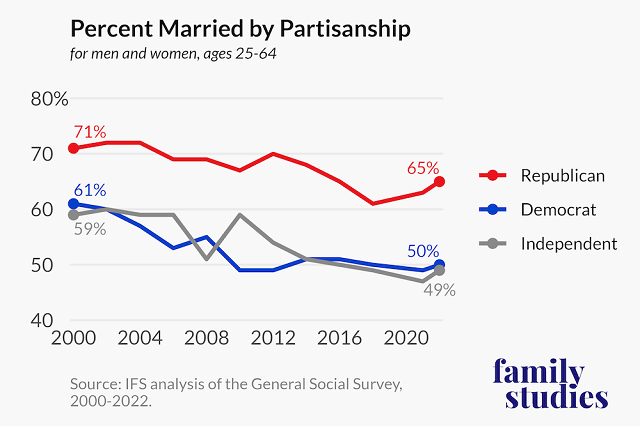
On the cultural front, the relative appeal of the institution of marriage among contemporary Republicans shows up in our analysis of the General Social Survey (GSS). Among adults in their prime (aged 25-64), Republicans were 10 percentage points more likely to be married than Democrats in 2000; today, they have a 15-percentage-point advantage when it comes to wedlock, with 50% of Democrats in their prime being married, compared to 65% of Republicans. Overall, then, the relative Republican advantage when it comes to being part of this fundamental social institution has grown a bit, even as fewer Americans—including Republicans—are currently married. Overall, about 55% of Americans aged 25-64 are married today, compared to 63% in 2000, according to the American Community Survey (ACS).
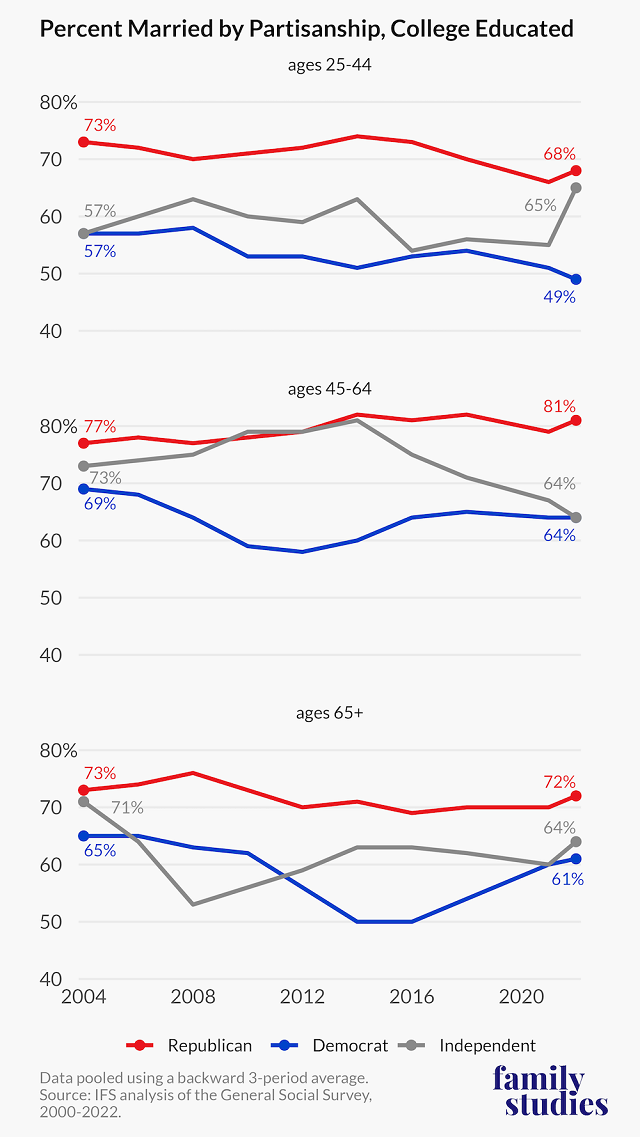
Breaking out partisan trends in marriage by age and education in the GSS, college-educated Republicans have generally been least affected by the nation’s retreat from marriage, and, at least in the younger and middle-aged categories, are most likely to see their marriage advantage grow relative to Democrats in the same educational bracket. For instance, the gap between Republicans and Democrats in the share married when it comes to college-educated young adults (aged 25-44) grew from 16 percentage points at the beginning of the twenty-first century to 19 percentage points today, and from eight percentage points to 17 percentage points for college-educated middle-aged adults (aged 45-64). It’s hovered closer to 10 percentage points for older Americans aged 65 and older. It is also striking that for virtually every college-educated group except young Democrats, the share of Americans who are married exceeds 60%. At the same time, as college-educated Americans have been moving towards the Democratic Party, the share of college-educated Americans aged 25 to 64 who are married has fallen from 67% in 2000 to 62% in 2022, according to the ACS.
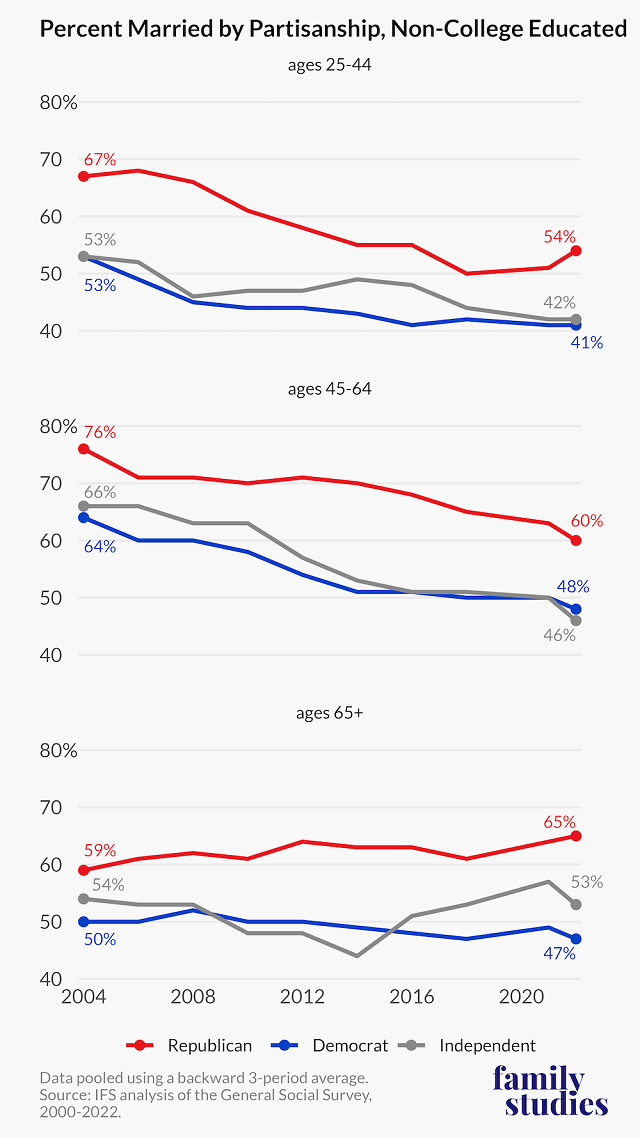
The partisanship and marriage story for less-educated Americans, who are both less likely to be married and less attuned to ideological positioning regarding marriage, is a bit different. We see a marked erosion in marriage for young and middle-aged adults (aged 25-64) of all partisan stripes, as well as a generally consistent gap in the share married between Republicans and Democrats of more than 10 percentage points.
Take less-educated young adults: From the early twenty-first century to the present, the share of men and women aged 25-44 who are married fell around 13 percentage points for both Republicans and Democrats, according to the GSS. The average overall decline in marriage from 2000 to 2022 for less-educated Americans aged 25-64 was 11 percentage points, according to the ACS. In 2022, 50% of less-educated adults aged 25-64 were married.
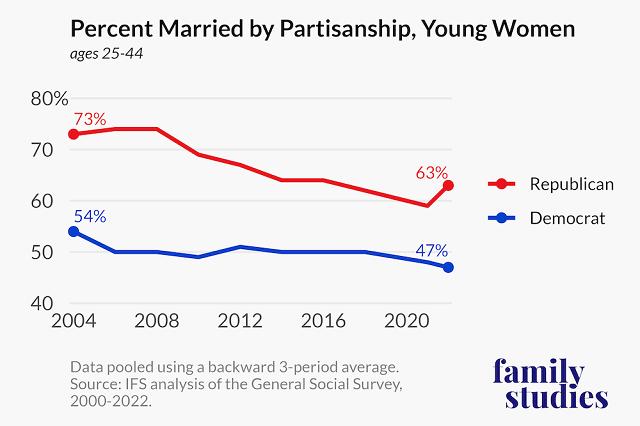
Finally, given the importance of gender among young adults in contemporary politics, we also look at partisan trends in marriage for young men and women (aged 25-44). The gap between Republican and Democratic young men grew slightly from 11 percentage points in the early 2000s to 13 percentage points today. But it shrunk a bit for young women, from 19 to 16 percentage points.
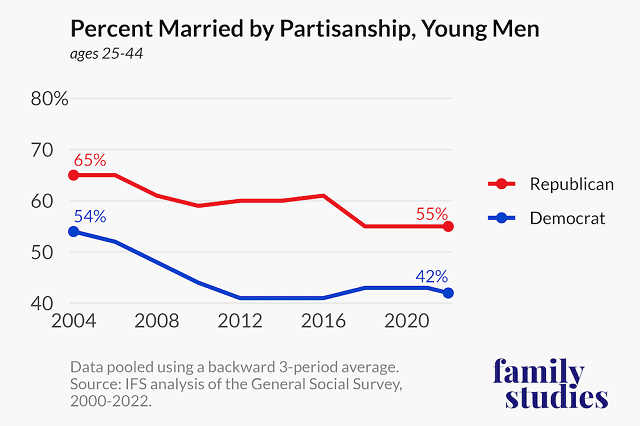
One bottom line is that a majority of young Republicans are married, whereas only a minority of young Democrats are married. But the other bottom line is that marriage has clearly eroded among both young Democrats and young Republicans. This is especially noteworthy because more young adults, especially women, have moved into the Democratic camp in recent years than vice versa.
Partisanship and Marital Quality
Most husbands and wives report they are happily married, as Get Married notes. But today, trends in marital happiness vary by class and culture. More educated and affluent Americans report higher-quality marriages, as do more conservative husbands and wives. What is striking about the class and culture story, however, is that one dimension of culture—partisanship—is more powerfully linked to marital happiness for less advantaged Americans.
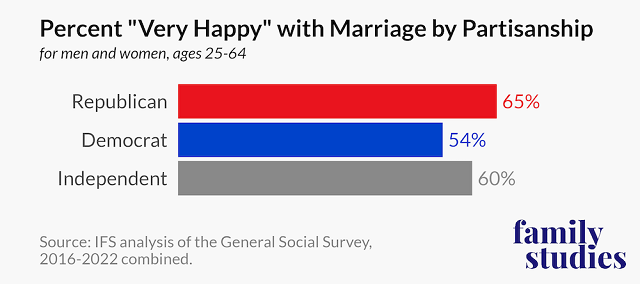
We know that Republicans are generally more likely to be “very happy” in their marriages compared to Democrats, and this advantage extends into the Trump era (2016-2022), according to the GSS. For instance, the partisan gap in the share of husbands and wives aged 25-64 who are “very happy” is 11 percentage points in combined GSS data from 2016 to 2022. That is, 65% of Republican husbands and wives were “very happy” in their marriages, compared to 54% of Democratic husbands and wives.
In Get Married, I (Wilcox) argued that conservatives are more likely to be happily married because they tend to place a premium on the institution of marriage itself and the virtues that foster strong marriages. For example, conservatives are more likely today to embrace “values like the importance of marriage, sexual fidelity in marriage, the idea that men and women are inherently different, and the value of religion.” All these factors are associated with happier marriages today.
In the aftermath of the Great Awokening, partisan and ideological differences around many of these cultural commitments have widened. We have seen, for instance, major differences opening up between Republicans and Democrats on the advisability of polyamory and the importance of marital fidelity. Arguably, these differences reinforce many Republican (and conservative) advantages when it comes to forging happy marriages.
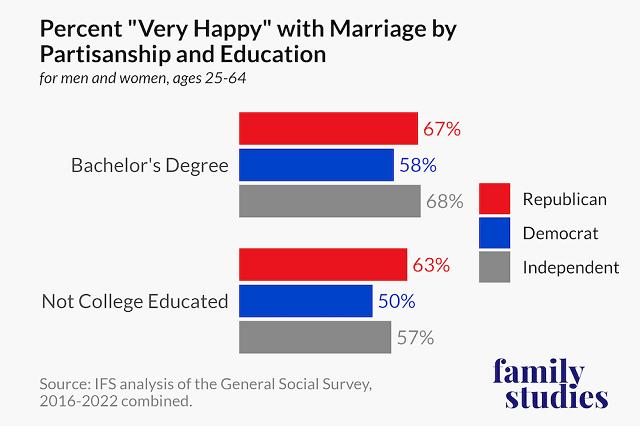
But what is less known is that the partisan marital happiness gap is larger among less-educated Americans. The gap between less-educated Republicans and Democrats in the share of husbands and wives aged 25-64 who are “very happy” in their marriages is 13 percentage points, compared with 9 percentage points among college-educated Republicans and Democrats in this same age group, according to combined GSS data from 2016 to 2022.
Which Party Has More Stable, Two-Parent Families?
Several scholars and journalists have argued that progressives are better at forging stable families today. According to journalist and economist Noah Smith, “liberal morality is simply better adapted for creating stable two-parent families in a post-industrialized world.”
Family scholars Naomi Cahn and June Carbone, authors of Red Families v. Blue Families, contend that blue (Democratic) states do better at fostering stable families than red (Republican) states. They believe that blue families who dominate Democratic states, more than red families, “encourage their children to simultaneously combine public tolerance with private discipline, and their children then overwhelmingly choose to raise their own children within two-parent families.” In their view, by stressing education, delayed marriage, and the responsible use of contraception, blue Americans are actually more likely to have the sort of stable, two-parent families that red Americans say they value.
But what these left-leaning observers miss is that particular family-friendly values—like commitment, marital fidelity, and the importance of marriage for the welfare of children—are also valuable when it comes to stabilizing contemporary marriages. And today these values and cultural commitments are more common in red families than blue ones.
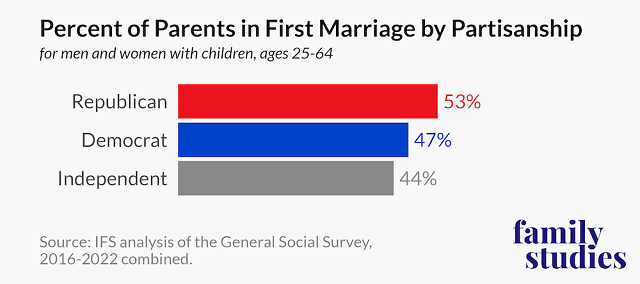
This is reflected in partisan differences in family stability. Republican parents are more likely to be in first marriages compared to Democratic parents. According to the GSS (2016-2022), 53% of Republican parents aged 25 to 64 with children of any age are in their first marriage, compared to 47% of Democratic parents. Although these cross-sectional findings do not allow us to make causal arguments about partisanship and family stability, they do suggest—contra Smith, Cahn, and Carbone—that Republicans have somewhat more stable families.
When it comes to class, the partisan gap in family stability is about the same for college-educated parents as it is for less-educated fathers and mothers. Among parents aged 25-64 who are college-educated, Republicans enjoy a seven-percentage-point advantage in the share who are in their first marriage, whereas among less-educated Americans, Republicans enjoy an eight-percentage-point advantage.
But these trends also reveal that education is a huge dividing line when it comes to family stability, as Cahn and Carbone would predict. The vast majority of college-educated parents of all partisan stripes are in their first marriages, whereas the same is true for only a minority of less-educated parents. At the same time, it’s college-educated parents who don’t lean blue—that is, more educated Republican parents—who enjoy the highest levels of family stability.
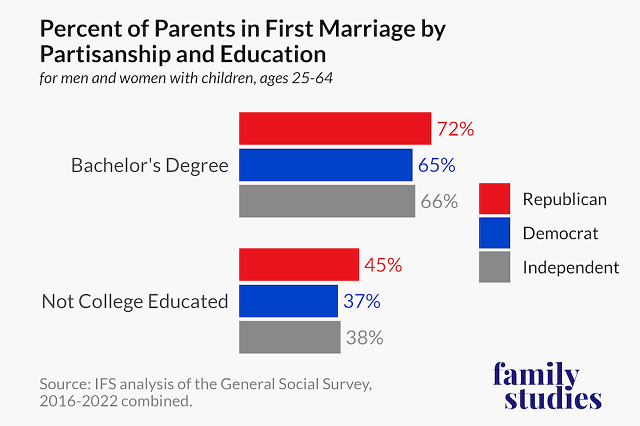
Get Married suggests two reasons why education and partisanship are linked to family stability. First, college-educated Republicans are more religious than any other partisan/educational subgroup. Second, college-educated homes across the board generally have more income, assets, and more full-time male breadwinners than less-educated homes. Given that religious attendance, financial security, and full-time male breadwinners are all linked to greater marital stability, class and culture both seem to play a role in fostering family stability in America—in ways that tend to put more educated and right-leaning parents at a particular advantage when it comes to family stability in the Trump era.

Patterns in divorce, however, do not indicate that Republican marriages are more stable, according to the GSS. Among ever-married Americans aged 25-64, Republicans are slightly more likely to have divorced. Specifically, 42% of ever-married Republicans in this age group have divorced, compared to 39% of ever-married Democrats. Republicans also are more likely to remarry: in this age group, only 10% of Democrats are remarried versus 16% of Republicans. These divorce trends can be explained, in part, by the fact that Republicans marry at earlier ages than Democrats. Cahn and Carbone would likely conclude that earlier marriage fuels slightly higher divorce rates for Republicans.
But in this age group of 25-64 year-olds, Republicans have also had more time to divorce because they get married earlier in life. By contrast, in this age group, Democrats have had less time to divorce because they marry later. And because the GSS data are not longitudinal, we do not know if the Republican rate of divorce for any given marriage is indeed higher. Additional research will have to determine, conditional on length of marriage, if Republicans or Democrats have greater risks of divorce.
Still, how do we reconcile higher rates of Republican family stability for prime-aged parents aged 25-64 with these divorce trends? Because they are more likely to get married and to marry earlier than Democrats, Republicans are probably more likely to have their children within marriage, and children with married parents vs. cohabiting or single parents enjoy more stability. Therefore, the advantage Republicans have when it comes to family stability for parents aged 25-64 may derive largely from the fact that Republicans are more likely to get married and to marry at younger ages than Democrats. Future research will have to explore trends in childbearing, marriage, and divorce by partisanship using longitudinal data to further understand these family dynamics.
Conclusion: Marriage in an Increasingly Polarized Era
There was a time in American life when marriage trends were not as polarized along political lines. But this has changedin recent decades, as Democrats have become especially likely to delay or forego marriage. Consequently, a partisan divide has opened up in the share of men and women who marry, just as there is now a marriage divide in support for the Republican and Democratic parties. Indeed, a recent Economist/YouGov poll of more than 1,500 registered voters finds that a majority (52%) of married voters are planning on voting for Trump even as a majority (53%) of unmarried voters are planning on voting for Vice President Kamala Harris in the upcoming presidential election. The poll also reveals that the marriage gap is about as large as the gender and education gaps in presidential voting plans. For instance, the gap in support for Trump versus Harris is 14 percentage points among marrieds versus a female voter gap of 11 points, and a college-educated voter gap of 14 points in the opposite direction.

More generally, this IFS research brief reveals that partisan gaps in the share of Americans who are married, happily married, and enjoy stable married families with children have persisted in the Trump era. In general, Republicans are more likely to be married and to be raising their children in a stable, happy family than Democrats. Over the last two decades, more educated and affluent Republicans have been especially protected from the nation’s retreat from marriage.
But we also acknowledge some important exceptions to these trends. The primary exception to the affinity between marriage and the Republican Party is that divorce is slightly higher among prime-aged Republicans (aged 25-64). This may be partly because divorced men have moved in large numbers into the Republican camp in recent years. It may also be due to the fact that Republicans marry at an earlier age, which may increase their lifetime risk of divorce. Another important exception is that a growing minority of less-educated Republicans are hailing from the ranks of unmarried Americans.
We think this partisan marriage gap is driven in part by the ways in which Democratic cultural commitments to our most important social institution have eroded more than Republican commitments—especially on key marital values and virtues, like the importance of sexual fidelity. This is understandable considering how the cultural fallout of the Great Awokening has been concentrated among Democrats. Indeed, one reason the partisan gap in who is married has grown more for college-educated Americans than less-educated Americans may be that college-educated Democrats have been influenced more than other groups by the cultural shifts in gender, sex, and family life associated with the rise of “woke” culture.
This Republican-Democratic divide is tragic because marriage and stable, two-parent families should not be partisan issues. The latest research tells us the American Dream is most attainable for poor children in communities where the two-parent family is strongest, that women and men are less likely to succumb to deaths of despair in communities where marriage is vital, and that classic American pursuit of happiness is most likely to be realized by married men and women with children. Strong marriages are good for the republic.
But declining Democratic (and progressive) support for the institution of marriage, and the values and virtues that sustain it, are likely to deepen the falling fortunes of marriage in America. That’s because a large minority of the rising generation is left leaning, especially young women, and because many of our most important cultural and political leaders are as well. Indeed, a big reason that the Democratic Party has backed away from the institution of marriage is that many of its most devoted supporters are single, left-leaning women. Another reason is that marriage and family life are increasingly coded as Republican issues.
Nevertheless, for their sake (Democrats are happier when they are married, too!), and for the sake of the nation, Democrats would do well to recover a renewed appreciation for our most important social institution, albeit on their own terms. Of course, at a time when American political life is polarized, and support for marriage varies so much by partisanship and ideology, this will be difficult. Given the importance of marriage for America, that is sobering news, not just for the state of our unions but for the State of Our Union.
Download a PDF of this IFS research brief here.
Brad Wilcox is the Future of Freedom Fellow at the Institute for Family Studies, and a professor and Director of the National Marriage Project at the University of Virginia. Wendy Wang is Director of Research at the Institute for Family Studies and a former senior researcher at Pew Research Center. Sam Herrin is a recent economics graduate from Georgia College & State University and a former intern at the Institute for Family Studies, who is pursuing a PhD in economics at FSU.
1. Using the General Social Survey (GSS), in this research brief we coded respondents who reported they were “Independent, close to Republican” as Republicans and “Independent, close to Democrat” as Democrats.
2. Note: the statistics reported in this brief refer to opposite-sex and same-sex marriages. Approximately 98.7% of marriages in the United States are made up of opposite-sex couples and 1.3% are made up of same-sex couples; and 99.4% of married families with children under 18 at home are headed by opposite-sex couples and .6% of married families with children under 18 at home are headed by same-sex couples, according to the 2022 American Community Survey (ACS).










